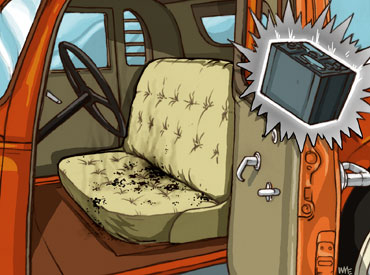Losses and Lessons: Battery blowout in a 1934 Plymouth
VEHICLE COVERED: 1934 Plymouth Rumble
WHAT WENT WRONG: A beautiful’34 Plymouth was parked in storage, and the driver had attached a battery tender to ensure it received an adequate charge while it wasn’t being used. Unfortunately, the battery ran out of water. The continuous charge prompted the battery to explode.
DAMAGE: As in many older car models, the battery was located under the floorboards inside the vehicle rather than under the hood. The explosion ripped through the wood and sprayed battery acid throughout the interior.
LOSS: $7,025.81
LESSON: Most cars have “maintenance-free” batteries – a permanently sealed battery that never needs water. But if you don’t have a maintenance-free battery, you must regularly fill it with water. If they run out of fluid, they can explode when a vehicle is started or if a battery tender is attached. Remember that even if the vehicle has never been driven, the battery still needs maintenance.
Marketplace
Buy and sell classics with confidence
BOTTOM LINE: You may think that most batteries are harmless, but those little boxes can pack quite a wallop if they’re not cared for correctly. In addition to checking the fluid levels regularly, always make sure you use distilled water. Using anything else can cause permanent damage. Also make sure you double-check the caps and straps after filling it up. A loose battery is like grenade without a pin.


